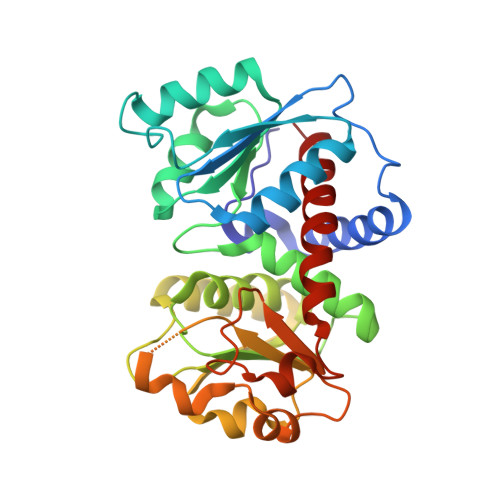The crystal structures of ornithine carbamoyltransferase from Mycobacterium tuberculosis and its ternary complex with carbamoyl phosphate and L-norvaline reveal the enzyme's catalytic mechanism.
Sankaranarayanan, R., Cherney, M.M., Cherney, L.T., Garen, C.R., Moradian, F., James, M.N.(2008) J Mol Biology 375: 1052-1063
- PubMed: 18062991
- DOI: https://doi.org/10.1016/j.jmb.2007.11.025
- Primary Citation of Related Structures:
2I6U, 2P2G - PubMed Abstract:
Mycobacterium tuberculosis ornithine carbamoyltransferase (Mtb OTC) catalyzes the sixth step in arginine biosynthesis; it produces citrulline from carbamoyl phosphate (CP) and ornithine (ORN). Here, we report the crystal structures of Mtb OTC in orthorhombic (form I) and hexagonal (form II) space groups. The molecules in form II are complexed with CP and l-norvaline (NVA); the latter is a competitive inhibitor of OTC. The asymmetric unit in form I contains a pseudo hexamer with 32 point group symmetry. The CP and NVA in form II induce a remarkable conformational change in the 80s and the 240s loops with the displacement of these loops towards the active site. The displacement of these loops is strikingly different from that seen in other OTC structures. In addition, the ligands induce a domain closure of 4.4 degrees in form II. Sequence comparison of active-site residues of Mtb OTC with several other OTCs of known structure reveals that they are virtually identical. The interactions involving the active-site residues of Mtb OTC with CP and NVA and a modeling study of ORN in the form II structure strongly rule out an earlier proposed mechanistic role of Cys264 in catalysis and suggest a possible mechanism for OTC. Our results strongly support the view that ORN with an already deprotonated N(epsilon) atom is the species that binds to the enzyme and that one of the phosphate oxygen atoms of CP is likely to be involved in accepting a proton from the doubly protonated N(epsilon) atom of ORN. We have interpreted this deprotonation as part of the collapse of the transition state of the reaction.
- Group in Protein Structure and Function, Department of Biochemistry, University of Alberta, Edmonton, Alberta, Canada.
Organizational Affiliation:

















